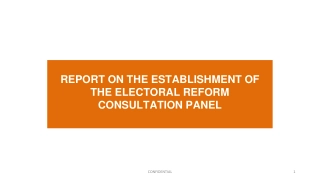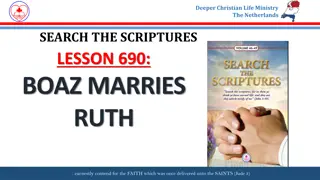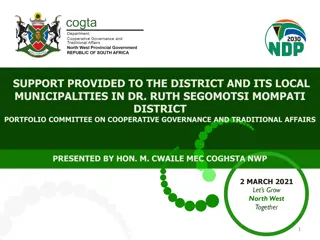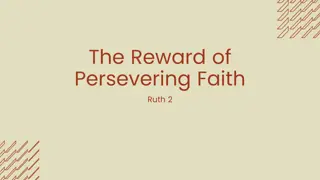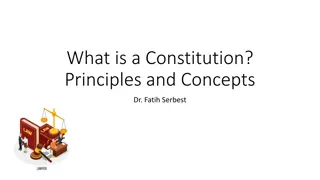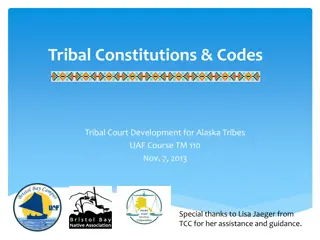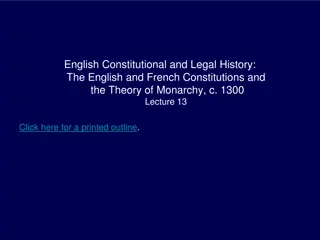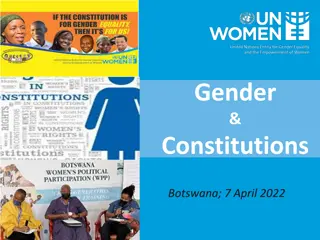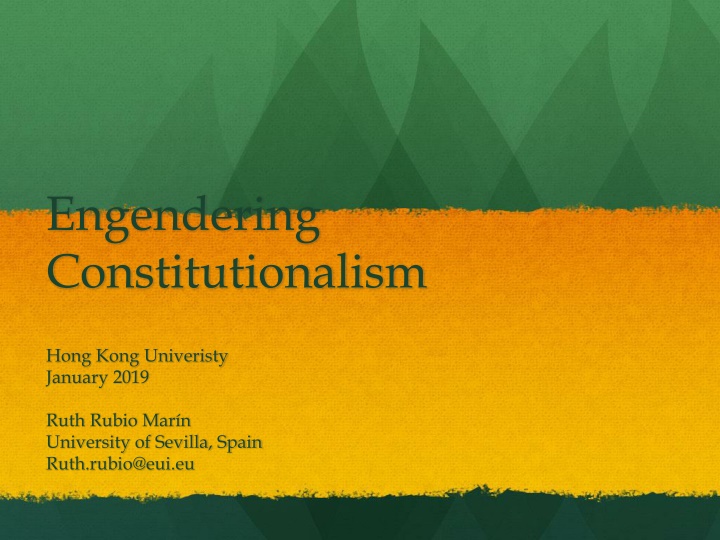
Empowering Women in Constitutionalism: Insights from Ruth Rubio's Research
Explore the in-depth analysis by Ruth Rubio on how women and sexual minorities influence constitutional norms, functions, and gender equality theories within various legal systems. Discover the role of women as norm creators and the functions of a constitution in defining political identity, organizing powers, and guaranteeing fundamental rights.
Uploaded on | 0 Views
Download Presentation

Please find below an Image/Link to download the presentation.
The content on the website is provided AS IS for your information and personal use only. It may not be sold, licensed, or shared on other websites without obtaining consent from the author. If you encounter any issues during the download, it is possible that the publisher has removed the file from their server.
You are allowed to download the files provided on this website for personal or commercial use, subject to the condition that they are used lawfully. All files are the property of their respective owners.
The content on the website is provided AS IS for your information and personal use only. It may not be sold, licensed, or shared on other websites without obtaining consent from the author.
E N D
Presentation Transcript
Engendering Constitutionalism Hong Kong Univeristy January 2019 Ruth Rubio Mar n University of Sevilla, Spain Ruth.rubio@eui.eu
WOMEN AND SEXUAL MINORITIES AS NORM CREATORS CONSTITUTIONAL FUNCTIONS & GENDER ORDER EQUALITY THEORY/RIGHTS/DOCTRINE SPECIFIC RIGHTS and DOCTRINES
WOMEN AS NORM CREATORS Women and Sexual Minorities as Creators of Constitutional Norms: -Constituent Assembly -Civil Society Input -Constitutional Courts -Constitutional litigants -powers of the Courts -standing rules -strategic litigation & other opportunities structures for civil society engagement (amicus)
FUNCTIONS OF A CONSTITUTION 1. Define the Political Identity of a Community 2. Organize Structure of Powers -Legislative, Executive, Judicial Branches -Federal Structure -Gender equality/ffrr protecting institutions (Ombudsperson/Equality Commissions) 3. Define Fundamental Rights -Spheres of non-interference (negative rights) -Forms of participation (active rights) -Services-enabling conditions by the state (positive rights) 4. Define Sources and Hierarchy of Norms 5. Guarantee Constitutional Supremacy-Stability
ENGENDERING A CONSTITUTION: ENTRY POINTS 1. DEFINE THE POLITICAL IDENTITY *Non-Sexism/Gender Parity Examples: art 3 of Croatian C.; art. 1 of French C.; art. South 1.b (non-sexism as foundational value) (non-heteronormativity) *Constitutionl Language (the universal male)
ENTRY POINTS: 2.STRUCTURE OF POWERS LEGISLATOR/EXECUTIVE/JUCIDIARY: composition/functioning -Measures to Ensure Participation of Women in the Legislator (mandatory candidate quotas/reserved seats) -Essence of Electoral system: proportional representation vs. majority/plurality systems -Measures to ensure gender parity in other powers FEDERAL STRUCTURE (centralization vs. de-centralization: supra-national, national, sub-national, local) -Representational, budgetary, regulatory, prioritization implications
ENTRY POINTS: 3.RIGHTS- CIVIL, POLITICAL, SOCIAL WHO DO THEY BIND? (horizontal versus vertical application-state action doctrine) ex: employment discrimination HIERARCHICAL ORDERING? (social rights weaker or of equal strength?) WHAT RIGHTS: IS THE LIST COMPLETE TO ENSURE WOMEN S AUTONOMY/DIGNITY (ex. reproductive freedom; life free of domestic violence) THEORY ON LIMITS OF RIGHTS (balancing, proportionality, absolute rights)
ENTRY POINTS: 4. DEFINE SOURCES AND HIERARCHY OF NORMS 1. RELATIONSHIP BETWEEN CONS.NORMS AND INTERNATIONAL (HHRR) NORMS -monist/dualist systems -hierarchical ordering 2. RELATIONSHIP BETWEEN STATE AND NON-STATE LAW (eg.Customary/Religious Law vs. State Law) -hierarchical ordering -who interprets non-state law? Who decides in case of conflict? 3. USE OF COMPARATIVE LAW
ENTRY POINTS: 5. GUARANTEE CONSTITUTIONAL SUPREMACY/STABILITY/FLUIDI TY 1. CONSTITUTIONAL AMENDMENT PROCEDURE (Flexible vs. Rigid C.) 2. CONSTITUTIONAL COURT/OTHER COURTS -Judicial review of legislation -Hermeneutics: originalist/teleological interpretation
EQUALITY THEORY, RIGHTS, DOCTRINE I -Adequate equality equality and antidiscrimination clause/doctrine: *domain of application (also private powers, also interspousal) *standard of review (rational basis, strict/intermediate scrutiny) *antisubordination (and not difference-focus) * substantive (versus formal) *affirmative action
EQUALITY THEORY, RIGHTS, DOCTRINE II *no requirement of intent *direct/indirect discrimination *narrow/broad definition of sex as antidiscrimination category (pregnancy, parental responsibilities) but also sexual orientation/gender/sexual identity/expressions *address intersectionality *adequate standards of proof (inversion of burden of proof)
SPECIFIC RIGHTS AND DOCTRINES Freedom of Expression Right to a life free of violence (not to be subject to inhuman treatment) Reproductive autonomy Privacy Right to marriage Rights to motherhood/pregnancy protections Marital equality Social rights
SPECIFIC RIGHTS AND DOCTRINES

